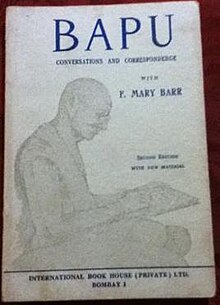Bapu is a word for "father" in many Indian languages such as Gujarati and Marathi, and may refer to:

Eknath Easwaran was an Indian-born spiritual teacher, author and translator and interpreter of Indian religious texts such as the Bhagavad Gita and the Upanishads.

Kasturba Mohandas Gandhi was an Indian political activist who was involved in the Indian independence movement during British India. She was married to Mohandas Karamchand Gandhi, commonly known as Mahatma Gandhi. National Safe Motherhood Day is observed in India annually on April 11, coinciding with Kasturba's birthday.
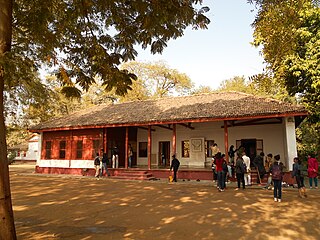
Sabarmati Ashram is located in the Sabarmati suburb of Ahmedabad, Gujarat, adjoining the Ashram Road, on the banks of the River Sabarmati, 4 miles (6.4 km) from the town hall. This was one of the many residences of Mahatma Gandhi who lived at Sabarmati (Gujarat) and Sevagram when he was not travelling across India or in prison. He lived in Sabarmati or Wardha for a total of twelve years with his wife Kasturba Gandhi and followers, including Vinoba Bhave. The Bhagavad Gita was recited here daily as part of the Ashram schedule.

Madeleine Slade, also known as Mirabehn or Meera Behn, was a British supporter of the Indian Independence Movement who in the 1920s left her home in England to live and work with Mahatma Gandhi. She devoted her life to human development and the advancement of Gandhi's principles.
Narhari Dwarkadas Parikh was a writer, independence activist and social reformer from Gujarat, India. Influenced by Mahatma Gandhi, he was associated with Gandhian institutes throughout his life. He wrote biographies, edited works by associates and translated some works. His writing also reflected Gandhian influence.
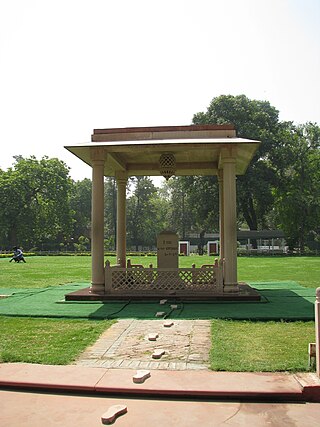
Mohandas Karamchand Gandhi was assassinated on 30 January 1948 at age 78 in the compound of The Birla House, a large mansion in central New Delhi. His assassin was Nathuram Godse, from Pune, Maharashtra, a Hindutva activist, a member of the Rashtriya Swayamsevak Sangh (RSS), a right-wing Hindu paramilitary organization as well as a member of the Hindu Mahasabha.

Sushila Nayyar, also spelt 'Nayar', was an Indian physician, a lifelong follower of Mahatma Gandhi, and a politician. She played a leading role in public health, medical education and social and rural reconstruction in India. She became Gandhi's personal physician and an important member of his inner circle. Later, she wrote several books based on her experiences. Her brother, Pyarelal Nayyar, was the personal secretary to Gandhi. In post-Independent India, she contested elections for political office and served as India's health minister.
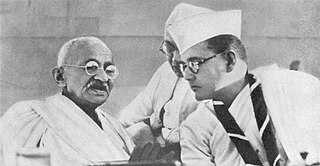
Subhas Chandra Bose, also known as Netaji, his political views were in support of complete freedom for India with a classless society and state socialism at the earliest, whereas most of the Congress Committee wanted it in phases, through a Dominion status.

Jagdish Chandra Jain was a scholar, indologist, educationist, writer, and freedom fighter during the freedom struggle of India. He authored over 80 books on a variety of subjects, including Jain philosophy, Prakrit literature, and Hindi textbooks for children. Jain was the chief prosecution witness in Gandhi's murder trial. He repeatedly tried to warn the government of the conspiracy to assassinate Mahatma Gandhi, which became to known to him after Madan Lal Pahwa, a Punjabi refugee and one of the conspirators of the murder of Mahatma Gandhi, confided to him of their plan. Jain's attempts to warn the government met deaf ears. He recounted his personal experiences in two books: I Could Not Save Bapu and The Forgotten Mahatma. He died from cardiac arrest in July 1993 in Bombay at the age of 84.

Hermann Kallenbach was a Lithuanian-born Jewish South African architect who was one of the foremost friends and associates of Mahatma Gandhi. Kallenbach was introduced to the young Mohandas Gandhi while they were both working in South Africa and, after a series of discussions, they developed a long-lasting association.

Nonviolent Soldier of Islam is a biography of Khan Abdul Ghaffar Khan (1890-1988), an ally of Gandhi's in the Indian independence movement. Originally written by Eknath Easwaran in English, foreign editions have also been published in Arabic and several other languages. The book was originally published in the United States in 1984 as A Man to Match His Mountains: Badshah Khan, nonviolent soldier of Islam. A second edition was published in 1999 with the title Nonviolent soldier of Islam: Badshah Khan, a man to match his mountains. Both editions include an afterword by Timothy Flinders. The 1999 US edition contains a new foreword by Easwaran, and an enlarged section of photographs of Khan. The book has been reviewed in magazines, newspapers, and professional journals. The book inspired the making of the 2008 film The Frontier Gandhi: Badshah Khan, a Torch for Peace.

Gandhi the Man is a biography of Mohandas Karamchand Gandhi written by Eknath Easwaran. The book was originally published in the United States in 1973. Several subsequent expanded editions have been published. Non-English editions have also been published in several languages.

Labanya Prabha Ghosh (1897–2003), also called Labanya Devi, a Gandhian, was a prominent personality of the Indian freedom movement, from Purulia District of West Bengal. She lived for almost 106 years and during later part of her life, was forced to live in a poverty-stricken ashram, her only source of income being a pension paid for freedom fighters. All through her life, before and after independence of India, she fought for justice of common man.

Conquest of Mind is a book that describes practices and strategies for leading the spiritual life. Written by Eknath Easwaran, the strategies are intended to be usable within any major religious tradition, or outside of all traditions. The book was originally published in the United States in 1988. Multiple revised English-language editions have been published, and translations have also appeared in several other European and Asian languages. The book has been reviewed in newspapers and magazines.
Kanu Gandhi was an Indian photographer. He was a grandnephew of Mahatma Gandhi who lived with him in several of his ashrams and was a member of his personal staff. He is best remembered as Gandhi's photographer, recording many moments of Gandhi's life on film from 1938 until his assassination in 1948. Following Gandhi's death, Kanu and his wife Abha moved to Rajkot where they ran a rural centre named after Kasturba Gandhi. Abha was one of the companions with Gandhi at Birla House Delhi, when Godse shot Gandhi.

The online Gandhi Heritage Portal preserves, protects, and disseminates original writings of Mohandas K. Gandhi and makes available to the world the large corpus of “Fundamental Works” which are useful for any comprehensive study of the life and thought of Gandhiji. Gandhiji was 24 years old in South Africa "Natal Indian Congress " made in 1894.
Rajmohini Devi was an Indian social worker, gandhian and the founder of Bapu Dharma Sabha Adivasi Seva Mandal, established by her in 1951. The famine of Surguja in 1951 involved a great scarcity of food grains and crop failure. The famine had direct bearing on the rise of a reform movement called Rajmohini Devi Movement, a non governmental organization working for the welfare of the tribal people of Gondwana, in the Indian state of Chhattisgarh. It was reported that she had a vision about Mahatma Gandhi and his ideals during the famine of 1951, and she started a movement, for the liberation of women. and eradication of superstitions and drinking habits among the tribal people. The movement gradually assumed the status of a cult movement with a following of over 80,000 people and was later converted into a non governmental organization, under the name, Bapu Dharma Sabha Adivasi Seva Mandal. The organization functions through several ashrams set up in the states of Chhattisgarh, Bihar and Uttar Pradesh.
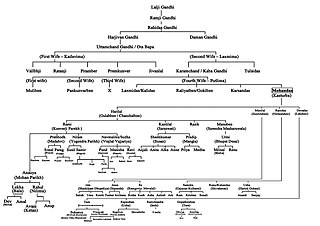
The Gandhi family is the family of Mohandas Karamchand Gandhi, commonly known as Mahatma Gandhi; Mahatma meaning "high souled" or "venerable" in Sanskrit; the particular term 'Mahatma' was accorded Mohandas Gandhi for the first time while he was still in South Africa, and not commonly heard as titular for any other civil figure even of similarly rarefied stature or living or posthumous presence.
Gandhi Memorial Asram popularly known as Sodepur Khadi Ashram is a heritage institution of Sodepur, Panihati, North 24 Parganas in the Indian state of West Bengal.
